Wendy Whelan’s “Restless Creature,” duets choreographed by Kyle Abraham, Joshua Beamish, Brian Brooks, and Alejandro Cerrudo. At Jacob’s Pillow, August 14-17.
Ballet dancers tend to have short careers onstage. If they retire at around 36 (as they often do), they’ve spent as many years training to dance as they have performing. Some stay in the field as teachers, choreographers, and company directors. Others become actors, photographers, lawyers, physical therapists, and more.
A few, however, need to continue dancing. Their bodies itch to move; new adventures don’t faze them. Some contemporary forms set no rules for body-shape or age, and eschew the flashy virtuosity that might tax a well-used body. Jirí Kylián formed Netherlands Dance Theater III to showcase stellar mature dancers. Rudolf Nureyev performed in works by Martha Graham and Paul Taylor, among others. So did Mikhail Baryshnikov, before he became even bolder—touring with Twyla Tharp, with Dana Reitz, moving on to Mark Morris and others in his White Oak Dance project, and finally, in his “Past Forward” program working with Judson Dance Theater’s 1960’s vanguard—Yvonne Rainer, Steve Paxton, et al. He’s still seeking out new choreography.
Do ballerinas pursue such venturesome paths? Not so much. When we speak of Wendy Whelan’s new program, “Restless Creature,” which premiered at Jacob’s Pillow on August 14, we may be talking about a fluke or a landmark. Who knows? Whelan is still performing principal roles in the repertory New York City Ballet, a company she joined in 1984—and performing them wonderfully. Her mind and body are a respository for choreography by Balanchine, Jerome Robbins, Peter Martins, Christopher Wheeldon, Alexei Ratmansky, and many others. She is 46.
In looking ahead, Whelan made an interesting decision—and one that requires stamina as well as daring. She invited four gifted male dancer-choreographers to create duets, which she would perform with them. Two of the men—Joshua Beamish and Alejandro Cerrudo—are still under 30; Kyle Abraham and Brian Brooks are under 40. Beamish, Abraham, and Brooks have companies of their own; Cerrudo is Resident Choreographer for Hubbard Street Dance Chicago. Whelan hoped that they would challenge her, excite her to go beyond what she knew—without, she must have presumed, destroying or denigrating what she has.
Some of the challenges are obvious. In working with these choreographers, she has had to give in to gravity in ways not common in the NYCB’s repertory and to experience different ways in which a man and a woman may form an onstage partnership. She has been asked to move small parts of her body—sometimes simultaneously—in ways that ballet dancers are rarely required to do. She is seldom supposed to resolve a movement in a pose. She has had to venture far off-balance before being caught. She has had to relinquish her pointe shoes, to let her bare feet feel the floor.
One interesting aspect of “Restless Creature” is the image it projects as a whole. Here is this fascinating woman—slim, delicate (albeit with the tensile strength of steel), expressive, yet cool. She enters one man’s world and dances with him, then another’s, etc. The dancer’s voyage is clear in the way Whelan performs each piece of choreography. Although she’s beautifully sure as a performer, she seems to be testing the steps, thinking about them, intently focused on what she’s doing. A restless creature exploring new terrain. But you can also come to see the evening as a woman’s progress through a series of relationships. This man asks things of her that others don’t. This man views her in one way, that one in another.
Cerrudo’s Ego et Tu announces the stage as a place that belongs to him, simply because he begins alone there in a pool of light (lighting design by Joe Levasseur), reaching out into the surrounding darkness. His dancing is all flowing. It ripples along with the second of five selections of music that he has chosen, Max Richter’s “The Twins (Prague)” from the record Memoryhouse. I find myself wishing Cerrudo would stop for a second, or move at a different speed.
In view of what happens later, I can think back on this solo in relation to a sense of loss and a dark river. As Cerrudo exits through the center of the black curtain at the rear of the stage, Whelan enters through the same portal; he doesn’t look at her as they pass, nor does she at him. She dances introspectively—like him, mostly in one spot and with something of his sinuousness, but with more subtle dynamic shifts. When she swings one leg around in the air, the move seems almost lush.
Several moments stand out. Cerrudo and Whelan face each other, and, without actually touching him, she appears to bump him with her head. He falls backward. The two walk toward one downstage corner of the stage. She is behind him, pressed against him, reaching around with one hand to cover his eyes. In the end, they walk toward that portal at the back of the stage, arms around each other. I’m not surprised that one of the music selections is “Orphée’s Bedroom,” from the piano suite Philip Glass derived from his opera Orphée. In it, Orpheus and Eurydice are reunited.
Beamish’s Waltz Epoca follows after a pause. The front curtain, by the way, is open when the audience enters the theater and doesn’t close between pieces, enhancing the image of the stage as an arena where the protagonists will meet. Whelan enters from a downstage corner, walks away from us on a diagonal, and exits. A red cloth of some kind hangs over one arm. Seconds later, she reappears, wearing a unitard in two shades of gray, and assumes a position on half toe, her feet pressed together in fifth position, her body held proudly erect.
This duet, set to mostly un-waltz-like music by Slovenian guitarist-composer Borut Krĭzsnĭk, is as enigmatically tricky and eclectic as the score. Some of the movements veer toward ballet, without really employing ballet steps. The two dancers angle their elbows, cock their wrists. Sometimes Whelan regards the audience with a fashion model’s hauteur. Beamish seems to be copying her opening moves, but, no, not exactly. When they intersect, she looks as if she doesn’t know he’s there, but she must realize that he is when he picks her up and drops her in a new spot. Once there, she walks her fingers down one of her legs.
It’s hard to know what’s in Beamish’s mind, and it’s probably a mistake to try to make sense out of the numerous interesting events he creates for the two of them. In sepulchral light, he deposits Whelan, kneeling and bent over, in the center of the stage. Slowly, a very large and ominous black object descends from overhead; it’s a spotlight, pinning her in its glare. He retreats upstage and becomes feline and watchful. Then the light gets pulled up again. He comes forward, his hands held out as if he were a waiter carrying a tray. After a quick trip offstage, she returns; the red fabric we saw earlier turns out to be the skirt of a red satin ball gown. She looks wonderful, and—perhaps with new confidence—puts her hand on his head and presses him to his knees. But they do waltz together, and, at the end, she’s spinning a circle around him while he waits for. . .I don’t know. . .his destiny.
In an interview, Abraham said that the title of his duet, The Serpent and the Smoke, refers to what he thought was a folk tale, although he has found no evidence of such a story. In his mind the serpent is entranced by the smoke, whose undulations suggest a mysteriously alluring female snake. It’s an interesting idea to think about as you contrast Abraham’s remarkable muscular fluidity with Whelan’s slightly lighter version of it. The music, two compelling collaborative pieces by the keyboard player Hauschka and the Icelandic cellist Hildur Guðnadóttir, is dark, deep-toned, eerie, and slow-moving.
Whelan is barely visible in the dark at the back of the stage when Abraham begins a solo downstage right. He is an amazing mover, fluid but particular; a small gesture may animate another located somewhere deep in another part of his body. He also has a command of dynamics. His slow undulations may be suddenly broken by a whiplash storm of small, quick moves. No wonder Whelan walks around him, as if trying to figure him out.
Abraham is equally interested in her—awed even. She wants to reach out a foot; he grasps it gently and helps it forward. She lifts a bent leg into a ballet passé; he, crouching beside her watchfully, puts a hand on her knee. But she is helpful too. They stand face to face; she holds his hips, and he, supported by that, arches backward, away from her. They do quite a lot of sinuous dancing, side by side, so that we can see how alike—yet how different—they are. In one curious moment, they skip, opposite each other, around in a circle. But the enigmatic ending is very satisfying. He retreats into near invisibility on the floor at the back of the stage, while she, in a beam of light, takes down her hair and shakes it out. After she has edged offstage, rippling her arms, he rises and assumes again the deep lunge in which he began.
Brian Brooks’s mesmerizing First Fall is the only duet on the program that’s not brand new. The Vail International Dance Festival commissioned and presented it in 2012. If you thought Whelan’s arms were getting a workout earlier in this program, this piece goes beyond that. It’s also a powerful end to the evening. The music’s several short pieces by Philip Glass (including—again—“Orphée’s Bedroom”). Like Glass, Brooks is interested in repetition. The many complexities in the first half of the duet never seem fussy because you understand quite soon that they’re part of a large single idea. Maybe it’s a game, maybe a task, yet there’s no goal but the doing. (I think I glimpse a smile on Whelan’s face—a rarity in this program). She and Brooks function as equal partners in a constant wreathing and tangling of arms, and a turning of bodies to accommodate that action. Seldom does one of the two grasp the other and hang on; maybe there is a goal, and it’s never to fulfill a move and acknowledge that it has been fulfilled. In a later passage, I think I discern different intentions. The two stand side by side facing us, and the liquid gestures of their arms now suggest that he is reaching to her, and that she is evading or deflecting his movements.
The last part of First Fall slows down, simplifies, and intensifies the atmosphere. Watching it, I think how difficult learning this dance must have been for Whelan. She is accustomed to being held on balance by a partner who turns her as if she were a top, and who catches her when she runs at him and jumps. Imagine her doing for the first time what Brooks asks of her. She stands still, facing the audience, her arms at her sides; he, behind her and in profile, begins to bend over. Slowly she falls back, arrow-straight. When her body touches his, they continue the downward trajectory together; he ends lying prone, with her draped across him.
Over and over, during this smooth, serene section, Brooks becomes Whelan’s fulcrum and cushion, offering his body so she can experience off-balance ways to travel. If she, lying on him turns on her side, he assembles himself and gradually rises to a crouch. Stretched in a cruciform shape and at a slant, she walks as he rotates. As he rises higher and higher, so does she. Then they can walk, side by side, until she feels like falling again. The several variations of this are performed calmly, carefully, trustingly, and tenderly. In the end the two reverse the spiraling walk and finish on the floor in darkness.
The dancers don’t take bows between pieces. On opening night, the four choreographer-performers appeared at the end of the program, acknowledging the audience’s cheers and joining the clapping for their brave, adventurous, and deeply beautiful partner, who kissed and applauded them all.
“Restless Creature” will tour in March and April of 2014 (with a run at the Joyce, April 2-7) and appear in London in July. (You can see part of Brooks’s dance on a short youtube documentary from the Vaill Festival, where it premiered.)

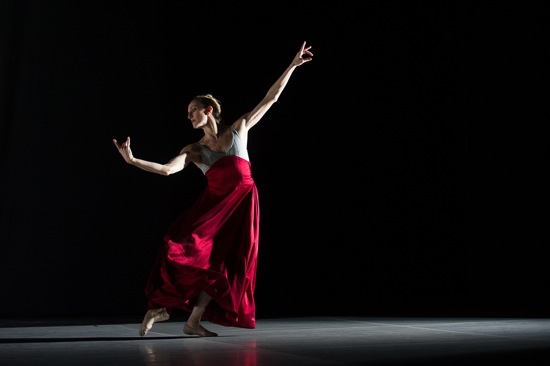
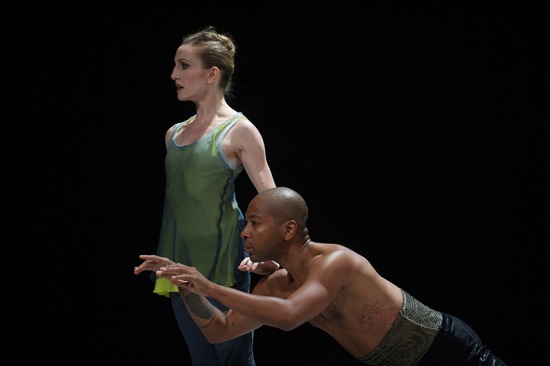
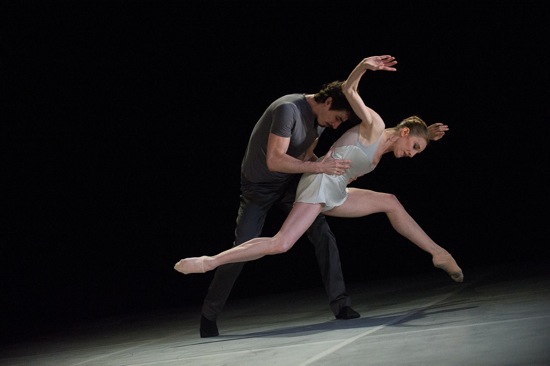
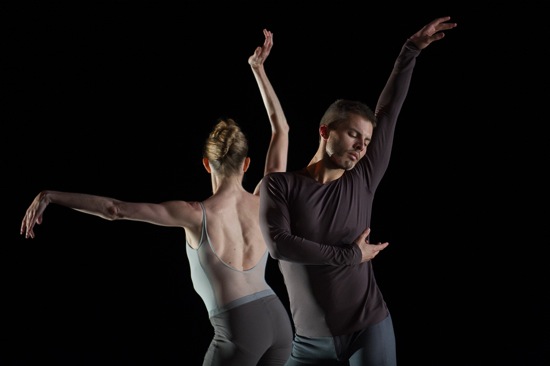
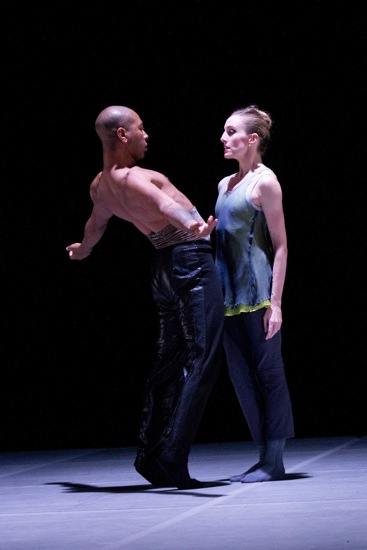
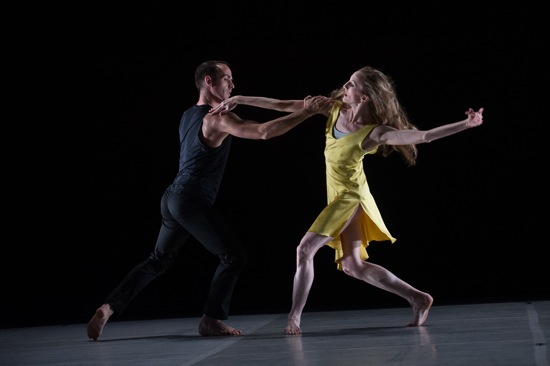
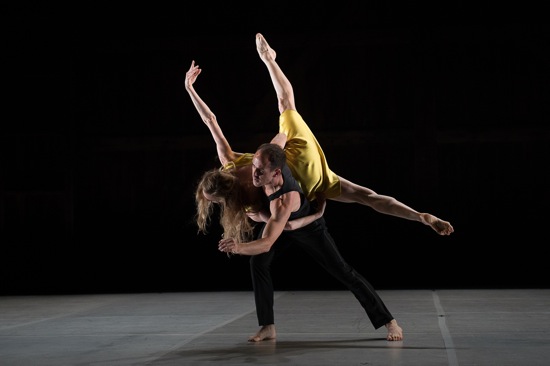
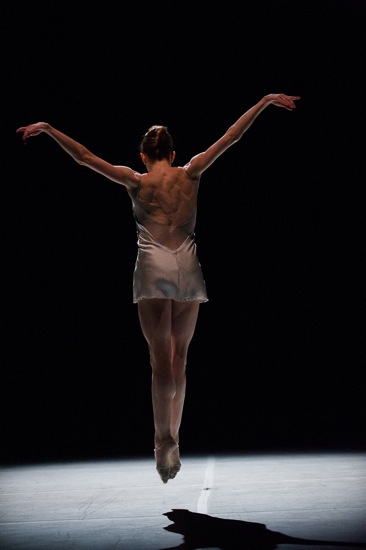
debby as always your reviews are illuminating.
just a foot note, Sylvie Guillem has been showing life after 35
in her asking several of the leading european choreogrpahers to choreography new and i must say very interesting ballet for her as she develops a new career away from the standard classical vocabulary.
making for her & we the audience a new vision of her amazing talent.
“She is behind him, pressed against him, reaching around with one hand to cover his eyes. In the end, they walk toward that portal at the back of the stage, arms around each other…..” Isn’t this a quote from Serenade?
And why does Beamish use an electronic version of Verdi’s Va Pensiero?
In the moment you speak of—a very brief one— Cerrudo could well have been referring to Balanchine’s Serenade, where it is an important image. It’s so well-known to me as a lover of the ballet, that whenever I think of Orpheus, I see that passage in my mind. Now that you mention it, I realize that it’s a much tenderer view of Orpheus and Eurydice returning from the Underworld. In myth and in Balanchine’s Orpheus, Eurydice (for all the wrong reasons) does her best to make Orpheus look at her.
I wouldn’t venture a guess as to why Beamish chose the music he did, nor why Borut Krĭzsnĭk would base a composition on a song from Verdi’s Nabucco (if indeed he did).In any case, my ears are not as educated as yours.
Thank you for this insightful piece on what for me was one of the most thrilling evenings of a lifetime of watching dance. I believe Wendy Whelan is the greatest living dancer, and “Restless Creature” reveals that her greatness is connected to her daring. She dances in the moment with exquisite focus. This is what art can be, what dancing can be.
You mention a moment in The Serpent and the Smoke in which Kyle Abraham appears to be “awed” by Wendy Whelan. In a word, that’s how I see her. The notes of uncertainty in your descriptions, the sense that you had to grapple with the dances (much as Whelan had to, and as her collaborators probably did as well), intrigue me.
With the usual provisions–God willing and the creek don’t rise, so to speak–I’ll be there at the Joyce when this program comes to New York next spring.